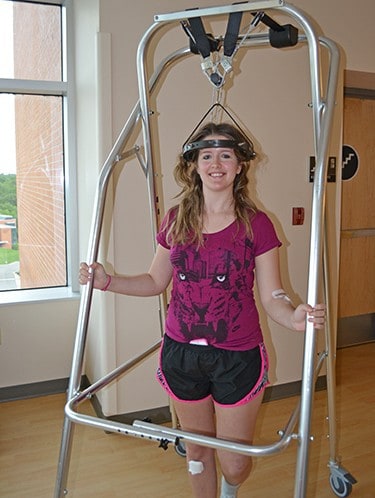Surgery Helps Teen ‘Blossom’ after Wreck
| 
Richard McCarthy, M.D., examines Collins’ neck during the first exam since her surgery.

McCarthy and Monir Tabbosha, M.D., lead Collins through stretching techniques after they corrected a tilt in her neck.

Paige Collins walks around UAMS before her surgery wearing a halo attached to a traction walking device.
July 8, 2014 | For two years, 18-year-old Paige Collins of Harrison thought her fate was to live with a tilted neck following a 2012 car accident — until she came to UAMS.
A tilted neck wasn’t her only injury. She endured a broken neck, fractured femur and tibia, internal bruising, and a T6 fracture.
But after undergoing surgery to repair the broken bones at another hospital she wasn’t out of the woods just yet.
Collins developed a fatty embolism from her long bone fractures in her leg that then spread to her lungs and, because of a congenital hole in her heart, spread to her brain, causing a stroke. At 16, she had to learn how walk and talk again.
“They were telling my mom they would have to put me in a nursing home or something like that and I was like, what?” Collins said.
Even after learning how to walk and talk again, and graduating high school only one semester behind, Collins’ doctors couldn’t figure out the source of her head tilt or the pain in her back. Her primary care doctor sent her to Richard McCarthy, M.D., chair of the Department of Orthopaedic Surgery in the UAMS College of Medicine.
McCarthy and Monir Tabbosha, M.D., assistant professor in the college’s Department of Neurosurgery, discovered Collins had a cervical spine dislocation, which they could correct by using a specialized surgical tool. Prior to surgery Collins needed to spend one week wearing a metal halo attached to her skull and to a traction walker device used to stretch the arteries and soft tissues prior to realigning the bones.
“When we saw her, we recognized that she had a problem with this dislocation,” McCarthy said. “So Dr. Tabbosha and I were able to work together and get the arteries stretched out with the traction and reduce the dislocation in surgery back to where it belonged.”
Collins’ mother, Jane Anne Beckham, was grateful that McCarthy was able to pinpoint the root of her daughter’s discomfort.
“When he identified that there was an additional break, then it was just great to have a plan of action and to know that she wasn’t going to be in that position forever,” Beckham said.
McCarthy and Tabbosha performed the surgery to correct Collins’ C1-2 spinal dislocation using an intraoperative CAT scan imaging platform called the O-arm Surgical Imaging System.
“Paige came to UAMS because we have an O-arm and the skills to fix her spine,” McCarthy said. “This was a very unusual surgery because usually you see these cases when they first happen. These trauma cases seen later can be problematic.”
Collins said she hasn’t experienced any problems since the surgery and is living a normal life again. After a few more months of physical therapy, she will be able to remove her neck brace.
“I see this as one of the last steps as far as her physical health and her really recovering and a boost to her confidence because she did have a head tilt,” Beckham said. “I’ve seen her blossom since the surgery.”